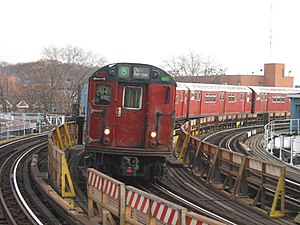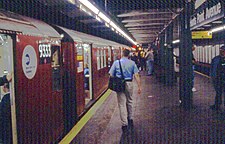
The 7 Flushing Local and <7> Flushing Express are two rapid transit services in the A Division of the New York City Subway, providing local and express services along the full length of the IRT Flushing Line. Their route emblems, or "bullets", are colored purple, since they serve the Flushing Line.

The Interborough Rapid Transit Company (IRT) was the private operator of New York City's original underground subway line that opened in 1904, as well as earlier elevated railways and additional rapid transit lines in New York City. The IRT was purchased by the city in June 1940, along with the younger BMT and IND systems, to form the modern New York City Subway. The former IRT lines are now the A Division or IRT Division of the Subway.

The New York City Subway is a large rapid transit system and has a large fleet of rolling stock. As of November 2016, the New York City Subway has 6418 cars on the roster.
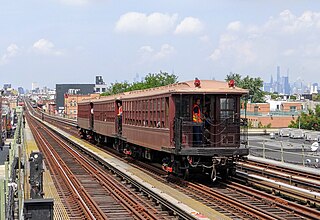
BU cars is the generic term for BRT elevated gate cars used on predecessor lines of the New York City Subway system. Various orders of these cars were built by the Osgood-Bradley, Brill, Cincinnati, Laconia, Pullman, Gilbert & Bush, Harlan & Hollingsworth, Wason, Pressed Steel, Brooklyn Heights Railroad, John Stephenson, and Jewett car companies.

The R33S was a New York City Subway car that was built by St. Louis Car Company in 1963 for the IRT A Division. They were purchased for service on the IRT Flushing Line, which was the closest line to the 1964 New York World's Fair. A total of 40 cars were built, arranged as single cars. While in regular service, each R33S was coupled to five two-car consists of R36 cars to make 11-car trains for the 7 and <7> routes.

The R36 was a New York City Subway car model built by the St. Louis Car Company from 1963 to 1964. The cars are a "follow-up" or supplemental stock to the A Division's R33s, which some of the cars closely resemble. A total of 424 cars were built, arranged in pairs. The order includes World's Fair cars comprising 390 cars, and Main Line cars comprising 34 cars.

The R10 was the first series of post-war New York City Subway cars. They were built by the American Car and Foundry Company from 1948 to 1949 for the IND/BMT B Division. A total of 400 cars were built, arranged as single units. Two versions were manufactured: Westinghouse (WH)-powered cars and General Electric (GE)-powered cars. The R10s introduced many innovations, including an all-welded low-alloy high tensile (LAHT) steel construction, dynamic braking, improved propulsion, and various cosmetic features.
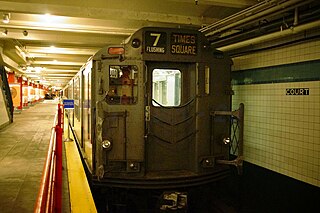
The R12 was a New York City Subway car built by the American Car and Foundry Company in 1948. A total of 100 cars were built, arranged as single units. Two versions were manufactured: Westinghouse (WH)-powered cars and General Electric (GE)-powered cars. The R12s were the first post-war city-owned rolling stock for the IRT A Division.

The R33 was a New York City Subway car model that was built by St. Louis Car Company in 1962 and 1963. The cars are a "follow-up" or supplemental stock for the A Division's R29s and closely resemble them. The cars were also referred to as R33MLs to distinguish them from the R33S's. A total of 500 cars were built, numbered 8806–9305, and arranged in pairs.

The R16 was a New York City Subway car model built by the American Car and Foundry Company from 1954 to 1955 for the IND/BMT B Division. A total of 200 cars were built, arranged as single units. Two versions were manufactured: Westinghouse (WH)-powered cars and General Electric (GE)-powered cars.

The R27 was a New York City Subway car model built by the St. Louis Car Company from 1960 to 1961 for the IND/BMT B Division. A total of 230 cars were built, arranged in married pairs. Two versions were manufactured: Westinghouse (WH)-powered cars and General Electric (GE)-powered cars.

The R30 was a New York City Subway car model built by St. Louis Car Company from 1961 to 1962. The cars were a "follow-up" or supplemental stock for the B Division's R27s and closely resembled them. A total of 320 cars were built, arranged in married pairs. Three versions were manufactured: Westinghouse (WH)-powered cars, General Electric (GE)-powered cars, and R30As.

The R17 was a New York City Subway car model built by the St. Louis Car Company in 1954 for the IRT A Division. A total of 400 cars were built, arranged as single units. Two versions were manufactured: Westinghouse (WH)-powered cars and General Electric (GE)-powered cars.
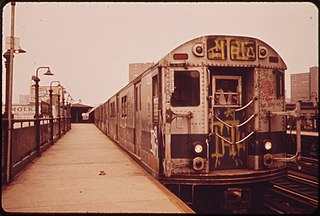
The R22 was a New York City Subway car built by the St. Louis Car Company from 1957 to 1958. The cars were a "follow-up" or supplemental stock for the A Division's R21s and closely resemble them. A total of 450 cars were built, arranged as single units. Two versions were manufactured: Westinghouse (WH)-powered cars and General Electric (GE)-powered cars.
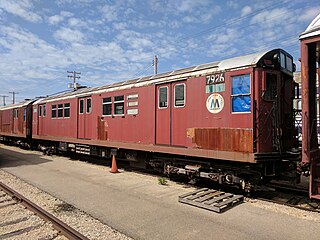
The R28 was a New York City Subway car model built by American Car and Foundry (ACF) from 1960 to 1961. The cars were a "follow-up" or supplemental stock for the A Division's R26s and closely resemble them. The average car cost per R28 was $114,495. A total of 100 cars were built, arranged in married pairs.

The R29 was a New York City Subway car model built by the St. Louis Car Company in 1962 for the IRT A Division. A total of 236 cars were built, arranged in married pairs.

The Q-type and QX were a New York City Subway car class originally built by the Osgood-Bradley, Brill, Laconia, and Jewett car companies, and rebuilt in 1938 by the Brooklyn–Manhattan Transit Corporation (BMT) from former BU cars.

The Deck Roof Hi-V was a New York City Subway car class built from 1907 to 1908 by the American Car and Foundry for the IRT and its successors, the New York City Board of Transportation and the New York City Transit Authority.

The Standard Lo-V was a New York City Subway car type built from 1916 to 1925 by the Pressed Steel Car Company, American Car and Foundry, and Pullman Company for the IRT. A total of 1,020 cars were built, which consisted of 725 motors and 295 trailers. It was the third and most common "Lo-V" type car ordered for the IRT.

The ME-1 was a rapid transit car built from 1925 to 1926 by the Standard Steel Car Company for the Staten Island Rapid Transit Railway Company and later also used in the New York City Subway. 100 cars were built, numbered 300–389 (motors), and 500–509 (trailers). They were the first electric cars to run in revenue service on the SIRT.
